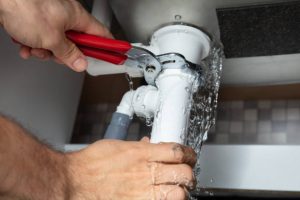
-
 1 Hour emergencyPlumbing, Drainage, Gas Fitting
1 Hour emergencyPlumbing, Drainage, Gas Fitting -



Does the sound of that leaking tap drive you crazy? Or maybe you’re stressing over how to fix it. We hear you, Leaking taps are an annoying problem that can make a lot of noise, and wastewater, and damage your fixtures.
Don’t worry though, because it’s often an easy fix. You don’t need to be a professional plumber to handle the job either — with the right direction, anyone can learn how to repair a leaky tap in about 15 minutes or less.
We’ll walk you through every step of fixing your leaking tap: from basic troubleshooting and prevention tips up to more advanced repairs. Let’s get started by looking at the most common causes of a leaky tap and some simple solutions.
If you’re dealing with a leaking tap, don’t worry—it’s definitely a fixable problem. The first step is to figure out what’s causing the leak.
There are a few things you can check:
– Is the tap installed correctly? If not, it may need to be tightened up or reinstalled.
– Is there anything blocking the tap? Anything preventing the parts of the tap from closing tightly could also be causing the leak.
– Are the washers (the rubber disks that come in contact with each other when you turn off your tap) in good shape? A worn or damaged washer may cause water to escape even when your tap is turned off.
– Is there any corrosion or scaling on the internal mechanisms of your taps? If so, this could be preventing it from closing properly and causing a leak.
Once you’ve figured out what’s causing your problem, it’ll be much easier to make a plan for how to fix a leaking tap.
Sometimes, fixing a leaking taps is worse than calling an emergency plumber. If you find yourself in a tricky situation and you don’t feel comfortable doing the work yourself or there is no easy solution, then a professional plumber may be the best option.
Here are signs that it’s time to call in an emergency plumber:
– If you don’t have the right tools or your existing tools aren’t working.
– If you can’t reach the tap you can fix it.
– If there is significant damage to the pipe or plumbing fixture.
– If your water continues to leak even after tightening screws.
– If plumbing fixtures are old and need to be replaced.
Getting help from a professional plumber is sometimes better than wasting time and money trying to fix something yourself without success. That said, if you ever do run into trouble, make sure you hire a licensed plumbing professional only – doing DIY jobs can lead to further damage and leave expensive repairs in its wake!
Replacing a washer is a fairly straightforward job and you don’t need to be a professional plumber to do it. First, turn off the water supply to the tap by turning off the valves that are located under your sink. Then, remove the handle of the tap and unscrew the nut that keeps it in place.
Once the nut is removed, you’ll be able to pull out the valve assembly. Inside it, you’ll find a rubber washer; simply remove it and replace it with a new one. When finished, put everything back together in reverse order and make sure all of your connections are tight!
You can get replacement parts at most hardware stores, so be sure to take your old washer with you when you go shopping so that you can match up sizes. And as long as you follow these steps carefully, you’ll have your leaking tap fixed in no time!
If you’re planning to fix leaking tap yourself, your first step should be to get the right tools for the job. This is important because a plumbing problem can quickly spiral out of control if you don’t have the right equipment.
What do you need?
Using a wrench is typically the best way to loosen and tighten nuts and bolts, so it’s important to have one in your toolbox. If you plan on replacing the washer in your leaking tap, make sure to select an appropriately-sized wrench so that it fits properly on the nuts and bolts.
Pliers are useful for gripping, twisting, or bending pipes and other fixtures. They come in a variety of sizes and shapes and are helpful for getting around difficult angles or tight corners. As with wrenches, make sure you choose pliers that are the right size for the job so that they can reach all of the necessary components.
A screwdriver is essential for disassembling your tap’s valve as well as for tightening screws when reassembling it after fixing any leaks. The most common types of screwdrivers are flathead and Phillips-head; make sure to select one with a size and shape that fits your particular bathroom fixtures.
With these three tools in hand you’ll be well-equipped to replace a worn washer or fix some other minor plumbing problems yourself—and hopefully take advantage of some stress relief while you’re at it!
So, you’ve decided to fix that pesky leaking tap on your own. Here are some tips and tricks for getting the job done.
First things first, shut off the water supply by turning the handle clockwise to close the valve. It’s super important that you do this before attempting any repairs.
Take a look for corrosion or other damage at the base of the tap. In some cases, you may be able to do a quick repair but if there is too much damage, it may be best to replace the tap altogether.
If everything looks okay and you’re ready to get started with repairs, start unscrewing the tap using an adjustable wrench or a spanner. Make sure you hold on to the tap securely so it doesn’t slip while you’re unscrewing it!
Now it’s time to change out some parts! You’ll need a new set of gaskets and seals; these can typically be found at your local hardware store or online. Keep in mind that each model of tap will have different sizes and shapes (so make sure you double-check before buying) and then install them according to the manufacturer’s instructions.
Once all of your new parts are installed, put everything back together (in reverse order of disassembly), and then make sure that all connections are secure by giving them an extra tighten-up with your adjustable wrench if needed. Finally, don’t forget to turn on your water supply valve so that you can test it out

Ah, the mystery of a leaking tap—it can drive you nuts, especially when you can’t figure out the cause. Fortunately, there are several common culprits behind a fixing a leaking tap.
If the internal components are old and rusty, then corrosion could be the cause of your leaking woes. This is because when metal corrodes, it creates spaces for water to escape. The good news is that replacing these internal parts is easy and relatively affordable.
Washers play an important role in preventing leaks from taps, as they are designed to create a seal that stops water from escaping from its designated route. If your washer isn’t doing its job, then it’s time to replace it with a new one. This requires taking away the tap head and screwing in a new washer—so get out your tools!
Sometimes all you need to do is tighten or loosen the faucet threads to stop the leak. However, if there are swollen O-rings around your faucet threads, these need to be replaced too—otherwise, they won’t form a watertight seal.
In any case, identifying what’s causing your leaky tap is essential for you to be able to fix it!
All in all, fixing a leaking tap can be a daunting task for some, but it’s not impossible. With the right tools, knowledge, and creative problem-solving skills, you can have your tap fixed and running back to its normal state in no time. If you do find yourself in a pickle, don’t stress – call an emergency plumber, who’ll be able to calmly and effectively diagnose and fix the problem.
The next time you hear your tap leaking, don’t panic. Follow these simple steps and you can be on your way to a hassle-free plumbing experience. So take a deep breath and get to work- and don’t forget to thank your lucky stars you don’t have to call in the emergency plumber this time.